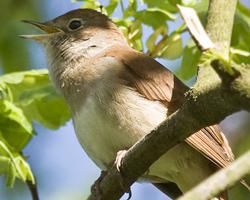
Váhy a míry
| Délka | od 13,5 do 14,5 cm |
|---|---|
| Hmotnost | 16 g |
| Délka rozpětí křídel | od 23 do 25 cm |
Popis zvířete
The Spotted Flycatcher, scientifically known as Muscicapa striata, is a small, unassuming bird that belongs to the Muscicapidae family, which includes various species of Old World flycatchers. This bird is particularly fascinating for its adept insect-catching abilities and its widespread distribution across Europe, parts of Asia, and Africa. It is a migratory species, spending its breeding season in temperate regions of Europe and western Asia before migrating to sub-Saharan Africa to overwinter.Adult Spotted Flycatchers measure about 13.5 to 15 cm in length, with a wingspan ranging from 23 to 25.5 cm. They weigh approximately 14 to 20 grams. Their plumage, while not particularly vibrant, is beautifully subtle and serves as excellent camouflage. The upper parts are predominantly a light grey-brown, with a slightly paler and more greyish hue on the breast and underparts. True to their name, these birds are characterized by a pattern of thin, dark streaks across their breast and flanks. Their heads may show a faint streaking, and juveniles often have a more pronounced spotted appearance that gradually fades as they mature.
One of the most distinctive features of the Spotted Flycatcher is its behavior. These birds are incredibly adept at catching insects in mid-air, a skill that defines their feeding habits. They typically hunt from a conspicuous perch in open spaces, watching for flying insects. Once an insect is spotted, the flycatcher darts out with impressive agility, captures its prey with a snap of its beak, and returns to the same or a nearby perch to consume its catch. This hunting method is both fascinating and effective, allowing them to catch a wide variety of flying insects, including butterflies, moths, flies, and beetles.
During the breeding season, which occurs from May to July, Spotted Flycatchers demonstrate a strong fidelity to their nesting sites, often returning to the same area year after year. Their nests are constructed with an array of materials, including grass, moss, and spider webs, and are usually placed on a horizontal branch or in a crevice on a tree, building, or other structure. The female lays 4 to 6 eggs, which she incubates for about two weeks. The chicks are altricial, meaning they are born blind and featherless, and rely entirely on their parents for food and warmth. Both parents are involved in feeding the chicks, which fledge approximately two weeks after hatching.
Unfortunately, like many migratory bird species, the Spotted Flycatcher faces threats from habitat loss, both in its breeding and wintering grounds, as well as from the dangers inherent in long-distance migration. Despite these challenges, it remains a common and widespread species, although its numbers have shown declines in some areas.
In summary, the Spotted Flycatcher is a remarkable bird, not only for its hunting prowess but also for its migratory habits and adaptability. Its presence across a wide range of habitats underscores the importance of conserving diverse ecosystems to support migratory species. Observing these agile hunters in action is a delight for birdwatchers and a reminder of the intricate connections within our natural world.
Podobná zvířata
Nové fotografie zvířat
Top 10 zvířat
- Dolphin gull (Leucophaeus scoresbii)
- Diana monkey (Cercopithecus diana)
- Moustached guenon (Cercopithecus cephus)
- Galápagos tortoise (Geochelone nigra complex)
- Japanese macaque (Macaca fuscata)
- Stone loach (Barbatula barbatula)
- Russian tortoise (Testudo horsfieldii)
- Greek tortoise (Testudo graeca)
- Common flying dragon (Draco volans)
- Vendace (Coregonus albula)


